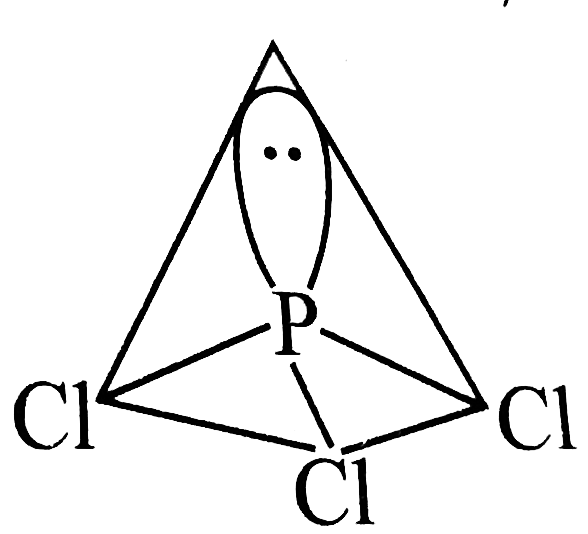Explain the non-linear shape of H2S and non-planar shape of PCl3 using valence shell electron pair repulsion theory.
Hybridisation of H2S and PCI3
(1) H2..S:⇒12(6+2)=4⇒sp3 Due
to two lp of e−'s it is V-shaped (like H2O)
(2) :PCI3⇒12(5+3)=4⇒sp3 Due to one lp of e−'s it is pyramidal in shape (like NH3) .

Topper's Solved these Questions
- BOOK - CENGAGE CHEMISTRY ENGLISHCHAPTER - CHEMICAL BONDING AND MOLECULAR STRUCTUREEXERCISE - Archives True/False7videos
CHEMICAL BONDING AND MOLECULAR STRUCTURE
- BOOK - CENGAGE CHEMISTRY ENGLISHCHAPTER - ATOMIC STRUCTUREEXERCISE - Concept Applicationexercise(4.3)19videos
ATOMIC STRUCTURE
- BOOK - CENGAGE CHEMISTRY ENGLISHCHAPTER - CHEMICAL EQUILIBRIUMEXERCISE - Subjective type1videos
CHEMICAL EQUILIBRIUM
Similar Questions
Interpret the non-linear shape of H2S molecule and non-planar shape of PCl3 using valence shell electron pair repulsion (VSEPR) theory.
(Atomic number :H=1,P=15,S=16,Cl=17)View SolutionInterpret non-linear shape of H2S and non-planar shape of PCl3 on the basis of VSEPR theory.
View SolutionThe geometry of ClO−3 according to valence shell electron pair repulsion theory will be
View SolutionThe geometry of ClO−3 ion according to valence shell electron pair repulsion (VSEPR) theory will be :
View SolutionThe space model which is obtained by joining the points representing various bonded atoms gives the shape of the molecule. The geometry of the molecule is definite relative arrangement of the bonded atoms in a molecule. The shape and geometry of a molecule is explained by valence shell electron pair repulsion theory given by Gillespie and Nyholm.
Which is not the electron geometry of covalent molecules ?View SolutionThe space model which is obtained by joining the points representing various bonded atoms gives the shape of the molecule. The geometry of the molecule is definite relative arrangement of the bonded atoms in a molecule. The shape and geometry of a molecule is explained by valence shell electron pair repulsion theory given by Gillespie and Nyholm.
Which is not the electron geometry of covalent molecules ?View SolutionThe space model which is obtained by joining the points representing various bonded atoms gives the shape of the molecule. The geometry of the molecule is definite relative arrangement of the bonded atoms in a molecule. The shape and geometry of a molecule is explained by valence shell electron pair repulsion theory given by Gillespie and Nyholm.
Which molecule has both shape and geometry identical ?
(I)SnCl2 (II)NH3 (III)PCl5 (IV)SF6View SolutionThe space model which is obtained by joining the points representing various bonded atoms gives the shape of the molecule. The geometry of the molecule is definite relative arrangement of the bonded atoms in a molecule. The shape and geometry of a molecule is explained by valence shell electron pair repulsion theory given by Gillespie and Nyholm.
Select the correct code for the following repulsion orders, according to VSEPR theory :
(I) lone pair -lone pair > lone pair-bond pair
(II) lone pair-bond pair > bond pair -bond pair
(III) lone pair -lone pair > bond pair-bond pair
(IV) lone pair - bond pair > lone pair-lone pairView SolutionThe space model which is obtained by joining the points representing various bonded atoms gives the shape of the molecule. The geometry of the molecule is definite relative arrangement of the bonded atoms in a molecule. The shape and geometry of a molecule is explained by valence shell electron pair repulsion theory given by Gillespie and Nyholm.
Select the correct code for the following repulsion orders, according to VSEPR theory :
(I) lone pair -lone pair > lone pair-bond pair
(II) lone pair-bond pair > bond pair -bond pair
(III) lone pair -lone pair > bond pair-bond pair
(IV) lone pair - bond pair > lone pair-lone pairView SolutionValence shell electron pair repulsion theory (VSEPR) provides a method for predicting the shape of molecules, based on the electron pair electrostatic repulsion.According to VSEPR model, molecules adopt geometries in which their valence electron pairs position themselves as far from each other as possible.The VSEPR model consider double and triple bonds to have slightly greater repulsive effects than single bonds because of the repulsive effect of π electrons.how ever, the lone pair creates the maximum repulsive effect.
Which of the following does not represent the isostructural pair ?View Solution

